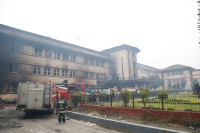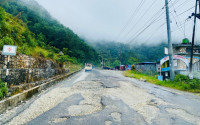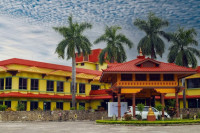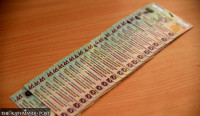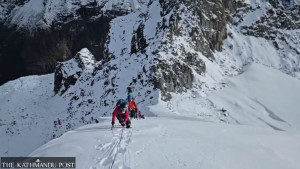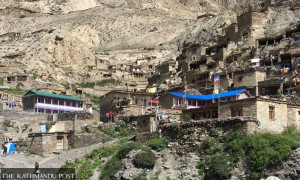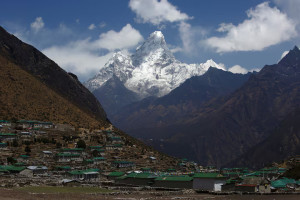National
Communist unity heralds ‘new era’
Two major national left political forces—CPN-UML and CPN (Maoist Centre)—merged to become the Nepal Communist Party on Thursday, 69 years after the communist movement gained momentum in the country with the establishment of a party by the same name.
Sanjeev Giri
Two major national left political forces—CPN-UML and CPN (Maoist Centre)—merged to become the Nepal Communist Party on Thursday, 69 years after the communist movement gained momentum in the country with the establishment of a party by the same name.
The development, hailed as “historic” by many, has created a single political party in the country with a strong hold in Parliament. The left alliance of the two parties formed in October garnered laudable public support in the federal and provincial elections held in December last year.
UML Chairman and Prime Minister KP Sharma Oli and Maoist Centre chief Pushpa Kamal Dahal signed the merger declaration note at a Unification Declaration Programme held in Kathmandu. The atmosphere at the City Hall auditorium, where party cadres and well-wishers gathered to witness the ‘historic’ event, turned euphoric as Chairmen Oli and Dahal put themselves at par as co-chairs with a common goal of unifying the country’s communist forces.
A joint meeting of the UML and the Maoist Centre held at PM Oli’s residence in Baluwatar earlier in the day announced formation of the NCP. Subsequently, Central Committee members of the NCP took their oath. Chairmen Oli and Dahal them administered the oath to each other. The meeting also decided to transfer all the properties owned by the two parties to the new political entity.
The NCP announced
a nine-member Central Secretariat. Apart from Co-chairs Oli and Dahal, the team has former PMs Madhav Nepal and Jhala Nath Khanal as senior leaders. Bishnu Poudel, one of the architects of the unification process, has been named general secretary while Narayan Kaji Shrestha has got the responsibility of spokesperson. The secretariat has senior leader Bam Dev Gautam, Defence Minister Ishwor Pokhrel and Home Minister Ram Bahadur Thapa as members.
The NCP will have a 45-member Standing Committee and 441 Central Committee members. The Standing Committee comprises 26 UML and 19 Maoist Centre leaders while the Central Committee has 241 UML and 200 Maoist leaders.
According to the declaration, the parties have agreed to highlight the positive aspects of the Janata ko Bahudaliya Janabad (People’s Multi-party Democracy), currently practised by the UML, and the Janabad of the 21st century, the guiding principle of the Maoist party, to create a new ideological framework governed by people’s democracy and socialism.
It took the two parties seven months to conclude the unification process. Initially, the left allies had made a tentative arrangement for announcing the union by mid-March, within a week of joint task forces submitted the draft statute and political report for the new party. However, the two panels were unable to produce the report by the March 9 deadline, which pushed back unification.
Then, both the parties proposed April 22 as the date for merger, to coincide the establishment of day of the Communist Party of Nepal in Calcutta in 1949. Amid growing differences between the two parties over power-sharing and unification modality, the merger did not happen as planned. The period also marked growing mistrust between Oli and Dahal over the former’s tendency of making unilateral decisions like shuffling of secretaries and centralisation of power at the Prime Minister’s Office.
In between, Dahal raised the issue of “respectable” power-sharing at the central committee and division of other party positions. Many saw this as Dahal’s bargaining to secure a central role in the new party post-merger.
Addressing the declaration programme on Thursday, NCP Co-chair Dahal likened the merger to formation of water through combination of hydrogen and oxygen, meaning that they would not be separated after unity. He hailed the unification as “a great step”,
adding that the new force would work for stability, development and prosperity of the people.
The other co-chairman, Oli, said both the parties had realised the dream of Pushpa Lal Shrestha, the communist party founder. “NCP has a majority in Parliament. A single party leads the government. The party also leads governments in six of the seven provinces. We have stupendous majority of popular votes and no one can shake our authority,” Oli said. “This authority will be centralised for betterment of the people and the country. We need to create policies and programmes to lead the nation to a new era.”
Nine-member Central Secretariat (in hierarchical order)
KP Sharma Oli ......................... co-chair
Pushpa Kamal Dahal .............. co-chair
Madhav Kumar Nepal ..... senior leader
Jhala Nath Khanal .......... senior leader
Bam Dev Gautam ........... senior leader
Narayan Kaji Shrestha ..... spokesperson
Ishwor Pokhrel ........................ member
Ram Bahadur Thapa ............... member
Bishnu Poudel ......... general secretary
............................................
A busy Thursday
8-10 am: Top leaders of both parties including KP Oli and Pushpa Kamal Dahal pay tributes to the late Madan Bhandari and Jibaraj Ashrit at Madannagar, Balkhu
11: Party Unification Coordination Committee meeting gave final nod to the unification proposal. 441-member central committee, 45-member standing committee and nine-member secretariat decided

2 pm: Separate meetings of the CPN-UML and CPN (Maoist Centre) central committees formally endorse party unification
3-4: At a joint central meeting in Baluwatar, Oli formally announces dissolution of both the parties and formation of the Nepal Communist Party

4-5pm: Central committee members of the new party administered oath
5-6 pm: Oli and Dahal, along with senior leaders, reach Election Commission to apply for party registration
6 pm: Formal announcement of party unification at City Hall

............................................
NCP Strength
Upper House
Total: 59
NCP: 39 3 (nominated by the President)
House of Representatives
Total members: 275
NCP: 174
- Key portfolios under the command of NCP leaders: President, prime minister, chairman and vice-chairman of National Assembly, Speaker and Deputy Speaker of the House of Representatives
- Six out of seven provincial governments led by NCP. Speakers and deputy speakers of provincial government also belong to NCP




 21.12°C Kathmandu
21.12°C Kathmandu


